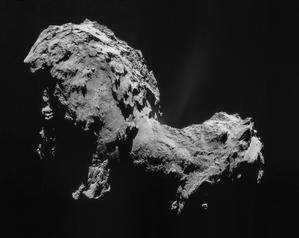Glossarbegriffe: Kometenkern
Description: Ein Kometenkern wird auch als Nukleus eines Kometen bezeichnet. Dieser Kometenkern ist ein festes Objekt, ähnlich einem schmutzigen Schneeball: Er besteht aus Eis und felsigen, staubigen Teilchen. In großer Entfernung von der Sonne besteht ein Komet nur aus seinem Kern. Erst wenn er sich der Sonne annähert, erhitzt das Sonnenlicht den Kometenkern. Dadurch sublimiert das Oberflächeneis, d.h. es geht sofort von einem festen in einen gasförmigen Zustand über. Das sublimierte Eis und der darin eingebettete Staub werden vom Kometenkern ausgestoßen. Dadurch umgeben sie den Kern mit einer Koma und es entsteht ein Kometenschweif, der von der Sonne weg zeigt.
Zugehörige Glossarbegriffe:
See this term in other languages
Term and definition status: The original definition of this term in English have been approved by a research astronomer and a teacher The translation of this term and its definition is still awaiting approval
The OAE Multilingual Glossary is a project of the IAU Office of Astronomy for Education (OAE) in collaboration with the IAU Office of Astronomy Outreach (OAO). The terms and definitions were chosen, written and reviewed by a collective effort from the OAE, the OAE Centers and Nodes, the OAE National Astronomy Education Coordinators (NAECs) and other volunteers. You can find a full list of credits here. All glossary terms and their definitions are released under a Creative Commons CC BY-4.0 license and should be credited to "IAU OAE".
If you notice a factual or translation error in this glossary term or definition then please get in touch.
Zugehörige Medien
Comet 67P/Churyumov-Gerasimenko
Bildnachweis: ESA/Rosetta/NAVCAM credit link
License: CC-BY-SA-3.0-IGO Creative Commons Namensnennung - Weitergabe unter gleichen Bedingungen 3.0 IGO icons









